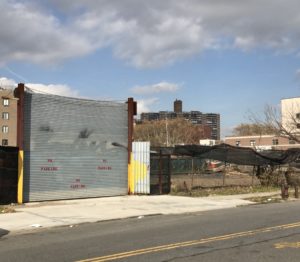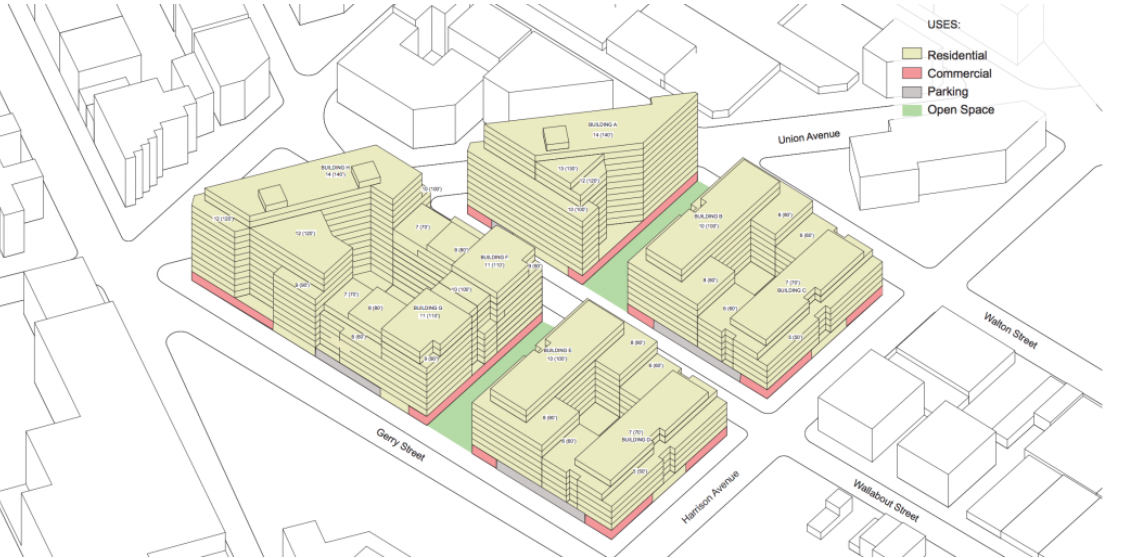
Last month, after years of debate, the City Council finally approved zoning changes that will allow the former Pfizer Company site to be redeveloped, creating an eight-building apartment complex inside what is called the Broadway Triangle. The debate was fierce because of charges that the project could prevent black and Hispanic families from getting housing. With the zoning question settled, it seems a good time to review the reasons behind such a claim.
The controversy began back in 2006, when the city began to push for more affordable housing in the area. Many projects were proposed for the triangle, but a judge later ordered an injunction to halt them—due to charges that the projects were effectively discriminatory. The injunction eventually delayed the former Pfizer site proposal later put forth by a private developer, Rabsky Group.
In 2009, the city was sued by an alliance of community groups calling itself the Broadway Triangle Community Coalition, which charged that the proposals for the triangle were discriminatory against black people and Latinos.
A settlement will be announced within the next few weeks between the city and the parties in that 2009 suit, according to legal documents and a representative for the Churches United For Fair Housing, one of the parties in the suit. No other details regarding the suit have been released.

The Contested Broadway Triangle
The Broadway Triangle development sits between Union and Flushing Avenues, with Broadway to the North. It lies at the convergence of three diverse neighborhoods—Bed-Stuy, Bushwick, and Williamsburg, each with different populations and housing needs.
According to the 2015 New York City Health Profiles, Bed-Stuy’s population is 64% black, 20% Hispanic, with the rest White, Asian, or “Other.” Bushwick is about 65% Hispanic, 20% black, with the rest white, Asian, and Other. Williamsburg is more than 60% white, including a relatively new group of mostly young people and a large population of Hasidic Jews. It is also 27% Hispanic.
When the city pushed for more affordable housing in 2006, many of the projects proposed by the United Jewish Organization and the Ridgewood Bushwick Senior Citizens Council received city support. According to their critics, these two developers were inexperienced with affordable housing and had previously made housing units specifically targeted at Hasidic Jewish families. In the meantime, the critics argued that the Jewish Hasidic community was getting a lion’s share of the new housing in the area. The Broadway Triangle coalition decided to act on what it saw as these sudden changes.
“If you look around, a lot of housing units have been constructed by private developers here in the Broadway Triangle. In those 1,000 units, not one of them are occupied by a black or Latino family. They have moved to the Bronx, Queens, Jersey—wherever they can afford,” said Alexandra Fennell, A Network Organizer for Churches United.
The Lawsuit
Churches United is one of 40 advocacy groups that form part of the Broadway Triangle Community Coalition. In 2009, they came together and claimed the city needed to be aware of racial inequities when supporting housing projects. The plaintiff argued that the large proposed development of the former Pfizer Company building was its exhibit A, violating several laws around housing discrimination.
The case was initially overseen by Justice Emily Goodman of Brooklyn, who ruled that it could proceed to trial on its merits. The suit claimed violations of the Federal Fair Housing Act. That law calls for “open, integrated residential housing patterns” and seeks to “prevent the increase of segregation, in ghettos, of racial groups whose lack of opportunities the Act was designed to combat,” according to case documents. After years of court proceedings, the case will be settled within the coming weeks, according to court documents and Fennell.
The Rabsky Housing Project
At the moment, the private developer Rabsky Group is proposing an eight-building project that would create 1,146 apartments—with 287 of those apartments, about 25 percent, considered permanent affordable housing for the Broadway Triangle. In addition, the project will also create 65,000 square feet of retail space and half an acre of public open space—out of a total of more than 4.2 acres of land that all belonged to Pfizer.
One key part of the dispute is the size of the available units. Community advocates have claimed that the project will continue to push the Black and Latino community out of Brooklyn, partly by having the apartment sizes target bigger families, by offering units with more rooms. According to Boris Santos, a Bushwick and Ridgewood City Council Organizer, if this project’s intentions are to target bigger families, it will make the housing problem much worse for smaller families, which are more typical in the Black and Latino community.

“In New York right now, the largest demand for housing is usually for one or two bedroom apartments. The average family size for a black and Latino family is about two or three people, which would necessitate a one or two bedroom apartment,” said Alexandra Fennell, Network Organizer for Churches United For Fair Housing. “So them proposing for larger bedroom apartments, essentially was giving preference to the Hasidic community, which tends to have much larger families, and are mostly living in that area currently.”
What Do The Locals Say?
We asked a few. Jonas Mills, 47, manages Nemo Enterprises Group LLC, a construction company on the Broadway Triangle. He isn’t too concerned about the new project because he already had a feeling the property he rents in the Triangle for his business was one day going to get sold to a developer. However, Mills says he has been surprised by the change in the area. He grew up in Brooklyn, but later had to move, he said, because he couldn’t afford housing there. His brother, who resides in the Marcy Houses, federal projects near the Broadway Triangle, has also noticed the changes, Mills says, because a lot of developers are building near his home.
“Everything is changing. I remember when this was all Latinos and blacks. Now, you barely see any of them. It is mostly the Hasidic community that you see around here,” said Mills. “But I am used to the change. I didn’t like the fact that I had to move, but I can’t do much about it. Now my brother at Marcy is going through the same thing. ”
On the other hand, Antonio Nieves, 20, who grew up around the Triangle, said he appreciates all the change in the area. He said the new developments are helping his community by changing the scenery. He doesn’t have an issue with anyone, he says, which is why he enjoys walking his dogs constantly around the area.
What Now?
Fennell, of Churches United, said that the coalition’s mission is not to end development in the city, but to oppose what she calls “irresponsible” development. In the Broadway Triangle, she says, because of its history as one of the most segregated neighborhoods in NYC, special considerations need to be made. Churches United argues that much more affordable housing should be built and that there needs to be thoughtful consideration of race in this project, she said.
Representatives from the Rabsky Group denied to comment to The Brooklyn Ink. But, according to the New York Daily News, Tom Corsillo, a Rabsky spokesman accused the Broadway Triangle Coalition of Anti-Semitism. “Opponents instead have waged an increasingly shameful campaign of anti-Semitic personal attacks, suggesting a Jewish developer can only be trusted to build affordable housing for Jewish people even though affordable units are awarded through a city-run lottery,” said Corsillo.
**************************
Update:
On December 4, the settlement was announced. According to the Churches United for Fair Housing, “Among other items in the settlement, the 375 apartments built at the Broadway Triangle site will be permanently affordable to low and moderate-income families. In addition, anyone forced out of the neighborhood in the last 9 years will also qualify for a preference in the affordable housing lottery. This recognizes the vast number of people displaced by the initial Bushwick rezoning, only to be cut out from the neighborhood’s publicly-subsidized affordable housing options.”


Leave a Reply